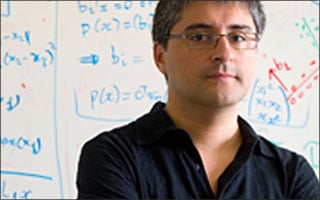Rene Vidal directs the Vision, Dynamics and Learning Lab to analyze and interpret vast amounts of data

Producing a computer application that can “see” images, analyze them, and interpret what they reveal is the goal of René Vidal, PhD, associate professor in the Department of Biomedical Engineering and director of the Center for Imaging Science’s Vision, Dynamics and Learning Lab.
“Our ability to analyze the overwhelming amount of existing visual data is very limited and mostly still done by humans,” Vidal says. For example, images from the London subway bombing in 2005 had to be analyzed by people, and useful information did not surface for several days. The same is true for medical data. Currently, there are 400 million medical procedures performed in the United States every year, all of which involve at least one medical image.
“Our goal is to develop algorithms that take vast amounts of data and produce interpretations,” he says. “Through this work we will ultimately be better able to analyze surveillance video, perform Internet searches, and, in medicine, search for biomarkers for disease. Better understanding of the information contained in vast numbers of images and videos will result, for example, in identifying the region of the brain affected by Alzheimer’s disease or determining a surgeon’s level of expertise.”
There are challenges, of course. The sheer number of images multiplied by the size of each — usually around 10 megapixels — is a huge volume of information to process. Vidal points out that not every bit of this information needs to be analyzed. “Our philosophy is that even though the dimension of data is high, the dimension of what you care about is much lower,” he says.
As Vidal refines algorithms that enable computer vision systems to focus on what is important and ignore the clutter, these systems will improve and provide more meaningful information.
